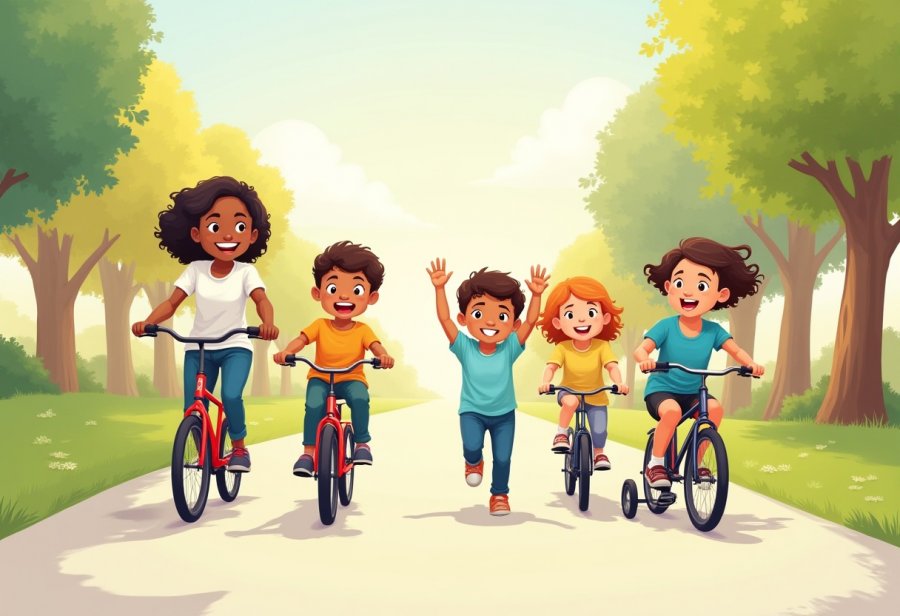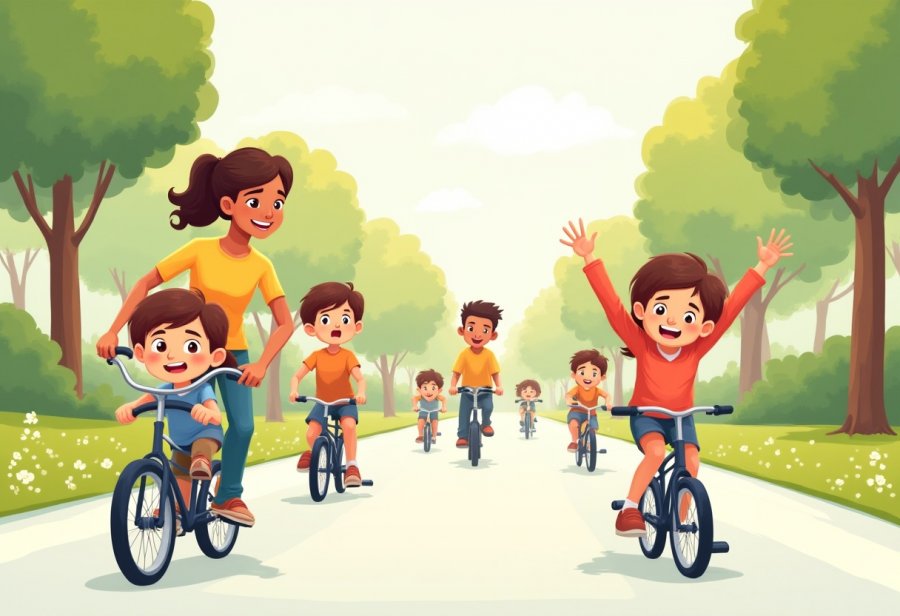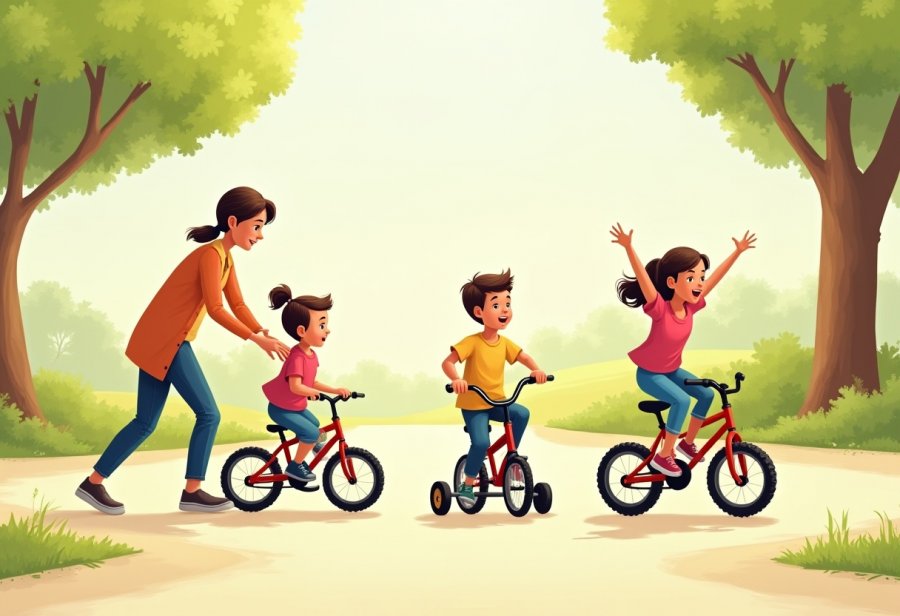Learning to ride a bike is more than a simple skill; it’s a profound journey of courage, resilience, and family bonds. This rite of passage embodies the transition from dependence to independence, where each wobble and fall teaches children that setbacks are temporary and perseverance leads to freedom. But does the fear of falling outweigh the thrill of independence? As families gather in sunlit parks, supporting their young riders, they reveal that the true lesson isn’t just about balancing on two wheels but about trusting oneself and facing fears head-on. Modern methods, like balance bikes and safety gear, make this milestone more accessible and joyful. Ultimately, conquering the challenge of riding a bike fosters emotional resilience and confidence that extend far beyond childhood—transforming vulnerability into empowerment. So, is overcoming fear the key to unlocking lifelong independence and adventure?

The Transformative Power of Learning to Ride a Bike: From Dependence to Independence
Learning to ride a bike is more than just picking up a new skill; it’s a defining moment that marks a shift from dependence to independence. For children, balancing on two wheels for the first time feels like stepping into a new world—one filled with possibilities, freedom, and self-trust. That initial wobble and fall are quickly forgotten when they finally glide forward confidently, their small faces lighting up with pride. It’s a powerful reminder that persistence pays off, and that overcoming fears can lead to a rewarding sense of achievement.
This milestone isn’t just about physical coordination; it’s deeply emotional. Families often gather to cheer on each small victory—whether it’s steadying the bike or pedaling a few more meters. These moments become bonding memories, built on patience, encouragement, and shared joy. Learning to ride becomes a symbol of perseverance, teaching kids that setbacks are simply part of the process and that resilience is essential for growth.
Practically, mastering balance on a bike involves more than just physical skill—it’s a lesson in trust and patience. Starting with balance bikes or training wheels allows children to focus on stability without the added complexity of pedaling. As their confidence grows, they transition smoothly to pedal bikes, feeling more prepared and less overwhelmed. This gradual process nurtures a positive attitude towards learning new things, reinforcing that progress often comes in small, manageable steps.
The emotional journey of learning to ride is as important as the physical act. When children fall, they learn that setbacks are temporary and that trying again is part of success. Supportive encouragement from parents and caregivers helps transform fear into courage, fostering emotional resilience. These early lessons in facing challenges head-on build a foundation that extends beyond childhood, shaping how kids approach future hurdles with confidence and grit.
Ultimately, learning to ride a bike is about more than just mobility; it’s about building a mindset of perseverance, trust, and independence. The thrill of that first solo ride is unforgettable—proof that courage and support can turn fears into freedom. It’s a universal rite of passage that teaches children that with patience, practice, and a little courage, they can overcome obstacles and explore the world around them with confidence.
Cycles of Culture: Tracing the Roots and Significance of Riding Across Societies
The act of learning to ride a bike has deep roots in many cultures around the world, often carrying a symbolic meaning tied to independence and childhood freedom. Historically, bicycles emerged in the 19th century as symbols of progress, mobility, and social change. In many societies, teaching children to ride was more than just a practical skill—it became a rite of passage marking their transition into greater self-reliance. For example, in early European communities, riding a bike represented moving beyond dependence on family and exploring the world on one’s own terms.
Different cultures have their own stories and traditions surrounding cycling. In some countries, bike riding became a communal activity that fostered social bonds and shared experiences. In places like the Netherlands or Denmark, cycling is woven into daily life, with children learning early as part of their routines. For many families, learning to ride was an essential step toward participating fully in community life, whether through school commutes or leisure outings. These cultural differences highlight how riding a bike can symbolize more than just personal achievement—it’s also about belonging and social connection.
As bicycles grew in popularity, their cultural significance shifted but remained strong. In the early 20th century, bicycles were seen as tools of liberation for young people, especially in urban settings where mobility meant more opportunities for work, education, and socializing. Learning to ride became a milestone that signaled a child’s readiness to take on new responsibilities and explore the wider world. These moments often carried a sense of pride and excitement that extended beyond the individual, symbolizing progress and modernity for entire communities.
Over time, societal attitudes toward children learning to ride evolved alongside urbanization and safety concerns. In earlier eras, children often explored freely, sometimes unsupervised, encouraged by the belief that independence was crucial for growth. As cities grew busier and awareness of accidents increased, safety measures like protective gear, supervised lessons, and designated cycling zones became standard. Despite these changes, the core idea persisted: learning to ride represented a vital step toward independence and confidence, a universal symbol of growth that transcended borders.
Today, the cultural significance of learning to ride continues to resonate across the globe. Many families and communities still celebrate the moment a child pedals without help or ventures out on their own for the first time. These milestones are emotionally charged, reinforcing the idea that cycling is more than just a skill—it’s a universal emblem of growth, resilience, and self-reliance. The shared experience of overcoming fears and mastering balance links different societies, emphasizing how this simple act of riding a bike connects us all in a common journey of development.
Through these evolving traditions and meanings, learning to ride has become a powerful metaphor for personal growth. Whether regarded as a rite of passage, a symbol of progress, or a childhood joy, cycling embodies the universal desire for exploration and independence. Across cultures and generations, that first pedal stroke signifies more than movement—it’s about stepping into a world of endless possibility and confidence.

Pedaling Into the Present: Modern Methods and Attitudes Toward Learning to Ride
Today, how children learn to ride bikes has evolved significantly, thanks to new tools and shifting attitudes around safety and independence. Balance bikes, for instance, have gained popularity because they focus solely on helping kids master balance without the added complexity of pedaling. Many parents find that children who start with balance bikes tend to transition more smoothly to pedal bikes, gaining confidence early on and reducing frustration. This approach makes the entire learning process more positive and less intimidating, setting kids up for success from the start.
Safety awareness has also transformed the way we teach kids to ride. Helmets, knee pads, and elbow pads are now standard gear, emphasizing injury prevention while making safety feel like a natural part of riding. Communities and schools increasingly promote supervised lessons and designated cycling zones, providing safe spaces where children can practice freely without the constant worry of traffic or hazards. These measures foster a sense of security, encouraging kids to try without fear and build their skills confidently.
Cultural attitudes toward children learning to ride have shifted too. There’s a growing emphasis on giving kids more independence, allowing them to explore and practice cycling with less direct supervision when appropriate. At the same time, structured lessons remain popular, especially in urban areas where traffic can be busier. This balance reflects a broader conversation about risk and trust—how much protection is enough, and when it’s time to let kids take the lead. Most agree that nurturing confidence and resilience is key, whether through guided instruction or encouraging free play.
Practices differ around the world, shaped by local environments and cultural norms. In many European countries, families and schools work together to create safe, supportive spaces for kids to learn. In densely populated cities elsewhere, parents often teach their children early on to navigate busy streets and crowded sidewalks. Rural areas in Africa or South America might see children learning informally from older siblings or neighbors, blending riding with daily chores and play. These variations highlight how community and infrastructure influence the learning process, but the core principles remain consistent: patience, gradual skill-building, and encouragement.
Today’s methods aim to make learning to ride enjoyable and confidence-boosting. The focus is on supporting children at their own pace, celebrating small successes along the way. Techniques like starting with balance bikes and offering gentle guidance help children develop independence without feeling overwhelmed. By fostering a positive environment—where falls are seen as part of learning rather than failures—parents and educators help build resilience, trust, and a lifelong love of cycling. This modern approach ensures that learning to ride remains a joyful milestone that nurtures growth, safety, and a sense of adventure.
Beyond the Pedals: Life Lessons and Practical Wisdom Gained from Riding
Learning to ride a bike offers valuable lessons that extend far beyond simply mastering balance on two wheels. It teaches patience and perseverance—qualities that are essential when facing any challenge. Every wobble or fall becomes a stepping stone, illustrating that setbacks are part of growth and that persistence ultimately leads to success. These early experiences foster resilience, shaping a mindset that can be applied to school, friendships, and future endeavors.
Family involvement plays a crucial role in transforming bike learning into a meaningful journey. Supportive encouragement from parents and caregivers builds trust and emotional security, turning small victories into powerful confidence boosters. Celebrating milestones like pedaling a few meters or maintaining balance longer reinforces the idea that effort and patience pay off, making the process enjoyable rather than frustrating.
The techniques used to teach kids—starting with balance bikes, gradually introducing training wheels, or offering steady guidance—are effective because they promote confidence step by step. Balance bikes allow children to focus solely on balancing, easing the transition to pedal bikes and reducing fear. This gradual approach nurtures a positive attitude toward learning new skills, emphasizing progress over perfection and making each attempt a chance to learn and grow.
Encouragement and gentle guidance foster resilience. Praising small successes and providing reassurance in moments of doubt help children develop a can-do attitude. When caregivers create a safe space where falling is seen as part of learning rather than failure, kids feel empowered to experiment and push their boundaries. This supportive environment is crucial for developing trust in their abilities and cultivating independence.
Learning to ride a bike also imparts important life lessons about risk-taking and self-trust. Overcoming fears of falling or failure teaches children that challenges are temporary and manageable. Facing these fears with patience and support builds emotional courage, encouraging them to explore new activities and take on future obstacles with confidence. These lessons in resilience and self-reliance become foundational for lifelong growth, instilling a sense of adventure and trust in their own judgment.

Balancing Bravery and Fear: The Emotional Journey of Learning to Ride and Its Lasting Impact
Learning to ride a bike is as much an emotional journey as it is a physical skill. Those initial wobbles, falls, and shaky starts are more than just hurdles—they’re opportunities for growth. Each stumble teaches children that setbacks are natural parts of learning, and that perseverance can turn fear into confidence. This process of overcoming challenges on two wheels helps build resilience, a trait that extends far beyond childhood and into all areas of life.
Supporting kids through their first bike rides requires patience and a calm, encouraging attitude. When caregivers stay positive and celebrate small victories—like balancing a little longer or pedaling further—they reinforce the idea that effort pays off. These moments boost self-esteem and teach children that persistence, not perfection, is what leads to success. Creating a safe, nurturing environment allows them to explore and experiment without undue pressure or fear of failure.
Fears of falling are a natural part of learning, but they don’t have to hold kids back. When children see that falling is just part of the process, they start to accept it as normal. This shift from dread to courage is crucial for developing emotional resilience. With gentle guidance and reassurance, kids learn that they can face challenges and that mistakes are simply stepping stones toward mastery.
Overcoming fears on the bike often translates into broader confidence. Children begin to realize that taking risks and pushing through discomfort leads to new achievements. These early lessons in trusting themselves and embracing uncertainty foster adaptability and a willingness to explore unfamiliar situations. The sense of independence gained from conquering those first pedal strokes becomes a foundation for courage in many other pursuits.
The confidence built during these early cycling experiences becomes a powerful tool for future challenges. When kids learn they can conquer their fears on two wheels, they carry that same self-trust into school, social settings, and new activities. These lessons in patience, resilience, and self-belief help them develop into resilient individuals capable of facing life’s obstacles with a positive outlook and a sense of adventure.
Creating a positive, supportive environment during the learning process is essential. When caregivers emphasize safety while encouraging exploration, children feel empowered rather than restricted. This balance of risk and reassurance allows kids to test their limits gradually, turning each fall into a stepping stone rather than a setback. Trust and encouragement create the space where true growth happens, making the experience memorable and meaningful.
In the end, learning to ride a bike embodies a universal truth: growth involves balancing courage with fear. Kids discover that facing worries head-on, with support, leads to confidence and independence. These early lessons—trusting themselves, embracing their fears, and persevering—lay the groundwork for resilience that lasts a lifetime. Riding a bike becomes more than just a childhood skill; it’s a metaphor for life’s broader journey of stepping outside comfort zones and trusting one’s own strength.